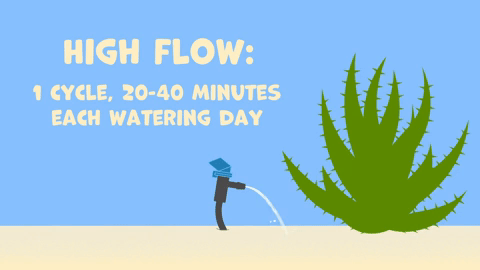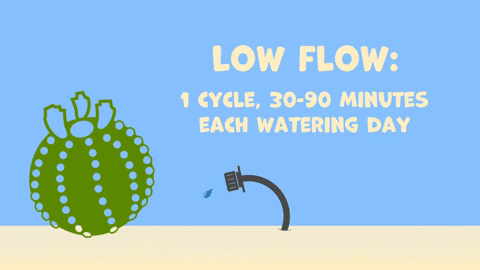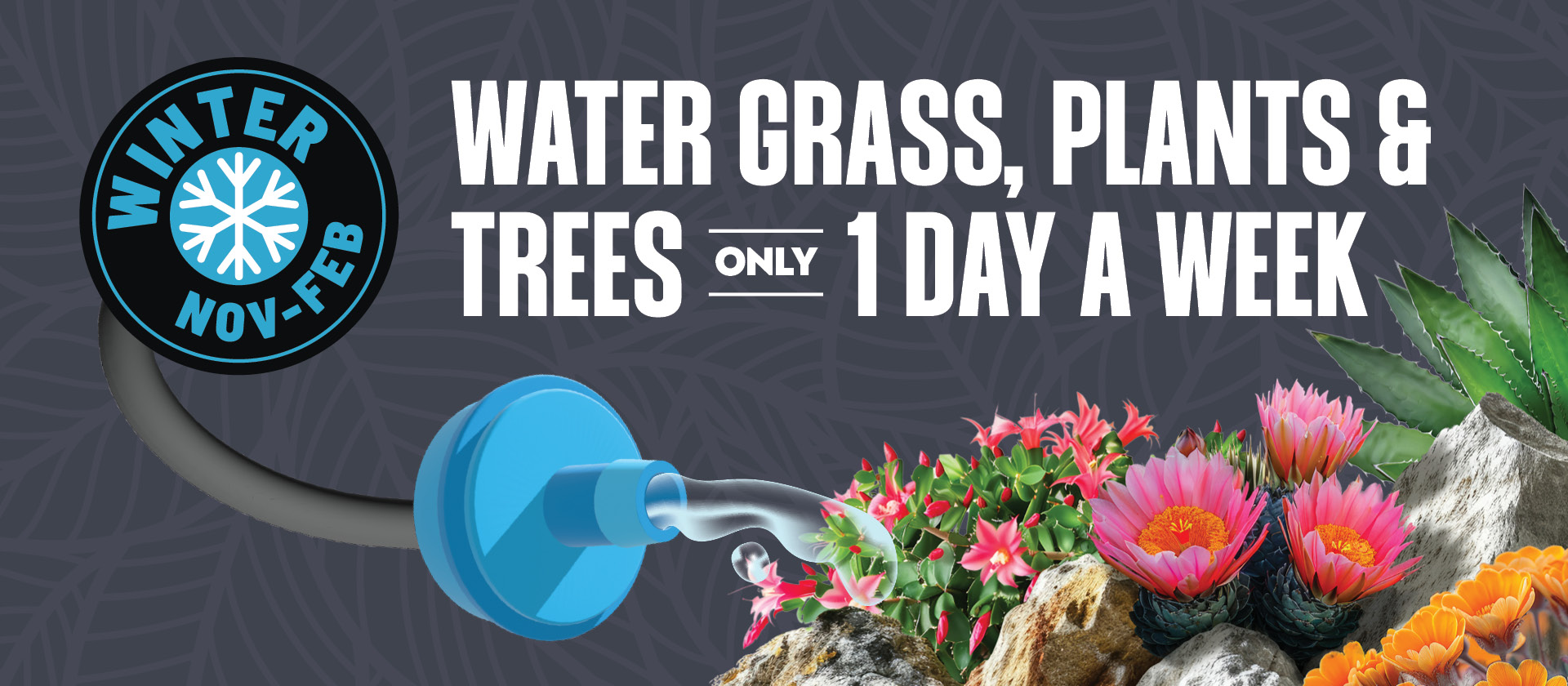Drip it, don't drown it.
Plants and trees need MUCH LESS WATER than grass. Not sure what the difference is between sprinklers and drip irrigation? You aren't alone.
When it comes to landscapes, watering isn't "one size fits all." How long and often you water your landscape depends largely on the type of plants, shrubs and irrigation components you have. It also varies by time of year.
Whether you have sprinklers or drip irrigation — or both — it's important to know the difference between them, how they work, and when to use them.

💧 Drip watering
Drip irrigation is truly beneficial to plants in desert environments. Drip irrigation systems deliver water more slowly and efficiently, and they should run longer but less frequently than sprinkler systems.
The length of each watering should be determined by the emitter flow rate, soil type, and weather conditions.
It's easy to accidentally overwater your plants on drip systems! Use the information on this page to determine the correct run times for your landscape.
How often to water
Seasonal watering restrictions apply to customers with drip irrigation systems. While drip irrigation may occur any day of the week, the number of days is limited by season.
Plants need far less water than grass. Here's how we recommend you run drip irrigation systems during each season:
- Winter: 1 day a week or less
- Spring and fall: 2 days a week
- Summer: 4 days a week
How long to water
Determine the amount of time to water based on the rate of flow of your drip emitters.


| Emitter type | Length of each watering |
|---|---|
| High-flow emitter (Up to 20 gph) | 20 - 40 minutes or less |
| Low-flow emitter (Up to 4 gph) | 30 minutes or less |
| Low-flow emitter (Up to 2 gph) | 60 minutes or less |
| Low-flow emitter (Up to 1 gph) | 90 minutes or less |
High-flow or low-flow? Don't know?
- Low-flow: Beads on tip or drips slowly
- High-flow: Streams like a water fountain
- gph: Gallons per hour, often marked on the emitter head. There are many emitter types.
Designing your drip system
A new plant may require only one emitter initially. As the plant grows, so does the demand for water. When a drip system is installed, it should be designed so it has the flexibility to change the amount of emitters and the location of the emitters in the landscape.
Each emitter should give you at least a 30-minute run time without runoff. Trees may also need more drip irrigation adjustments as they mature.
Free drip classes available! Learn how to design and install a drip irrigation system, and build a model right in the classroom.
Maintaining your drip system
Check your drip line periodically for breaks and check emitters for clogs or heads that have broken off. Ensure that each emitter is releasing the proper amount of water.
- Hold your finger over the emitter's outlet for a few seconds, so that the water can flush back and clean the emitter to help unclog it.
- Change the drip irrigation lines and filters at least twice a year, or whenever you change your irrigation schedule.
- Find the "end cap" on your drip line. This should be at the furthest point from your valve box. Open the cap and briefly run the system to flush out any debris that could be clogging your line. Turn off the water before trying to recap your line.
🌳 Tree irrigation
Trees should be watered well enough to penetrate the soil to a depth of 18 to 24 inches. The type of tree and the season will determine a watering schedule.
Avoid these mistakes when dealing with drip irrigation for trees:
- Setting your irrigation controller for your tree to run the same as spray irrigation
- Mixing irrigation components
- Not using filters or pressure regulator
- Not properly burying drip irrigation lines
- Applying too much gravel mulch before establishing wetting patterns
- Poor emitter placement which results in poor wetting patterns
- Not maintaining the drip irrigation system

💦 Sprinkler watering
The type of grass you have will determine how much water your lawn requires. Adding or removing one minute from a 4-minute sprinkler cycle, for example, will change the amount of water you use by 25 percent.
When to water
Water during the warmer part of the day during winter months to prevent water from freezing on your landscape. Water between midnight and sunrise from May to October to minimize water lost to evaporation.
Monitor how many minutes you can run your sprinkler system before water starts to run off the property. Stop the run cycle at that point. Allow the water to be fully absorbed before beginning the next cycle.
Sprinkler tips
- Warm-season grasses, such as Bermuda, require about one-third less water.
- If you have rotating sprinklers, water for 12 minutes each watering, rather than 4 minutes.
- Don't water when it's windy or rainy.
- Water your lawn on a separate schedule from your plants, trees and shrubs.
- Test, adjust and repair your sprinkler heads and drip emitters weekly in the summer and monthly in the winter.
- Always check your sprinkler system for malfunctions after mowing.
- Modify spray patterns from sprinkler heads by re-adjusting for better direction or installing variable arc nozzles.
- Use an SNWA instant rebate coupon to replace your irrigation clock with a smart controller.
- Get a rebate to replace your water-thirsty grass with a water smart landscape.
How to water grass
Our parched desert soil makes it tough for water to soak in very deep. That's why we suggest three 4-minute watering cycles.
- SHORT CYCLES each watering day
- MINUTES each cycle
- HOUR BREAK between cycles
12 minutes total DAILY MAX
Seasonal tips
An important part of a healthy, beautiful landscape is efficient watering for the appropriate season.
- Mandatory spring watering restrictions: During March and April, landscape irrigation is limited to three assigned days per week. Watering restrictions also apply to drip irrigation. Sunday is not an optional watering day. Find your watering group.
- Drip watering: Drip irrigated landscapes need far less water than grass. We recommend watering two days a week in spring. The length of watering depends upon the type of drip emitter. Learn more about drip irrigation.
- Spring ahead for Daylight Saving Time: Don't forget to set your irrigation clock ahead an hour when daylight saving time begins on the second Sunday in March. This also is a great time to check your clock's batteries.
- Save water on rainy days: Turn your irrigation clock off on rainy days or replace it with a smart irrigation clock to do the work for you.
- Check your irrigation system: Inspect filter screens for damage and clean them by opening the end of the filter and running water through briefly. Then, soak the screens in a 50/50 water and vinegar solution if there is mineral buildup. To flush the irrigation lines, find the end cap and briefly run the system to flush out debris. Check valve boxes for debris buildup or muddy conditions indicating poor drainage.
- Mandatory summer watering restrictions: From May 1 through Aug. 31, mandatory watering restrictions prohibit landscape irrigation between the hours of 11 a.m. and 7 p.m. Watering is allowed Monday through Saturday. Watering on Sundays is always prohibited. Find your watering group.
- Drip watering: Drip irrigated landscapes need far less water than grass. You only need to water plants and desert landscapes four days a week in summer. The length of watering depends upon the type of drip emitter. Learn more about drip irrigation.
- Ramp up summer watering gradually: The impulse to crank up landscape watering is strong when temperatures start getting hotter, but grass, trees and plants actually don't need as much water as we sometimes think. In May, while nights are still cool, gradually increase your sprinkler watering from three days to four. From there, keep an eye on your landscape and increase watering only as needed into June, July and August.
- Water before sunrise: Water in early morning hours before sunrise to minimize the amount of water lost to evaporation and daytime winds.
- 12-minute watering: We recommend watering lawns three times a day for four minutes during each watering.
- Save water on rainy days: Turn your irrigation clock off on rainy days or replace it with a smart irrigation clock to do the work for you.
- Brown spots: Hand-water brown spots and check your irrigation system to ensure it is providing “head to head” coverage.
- Extremely dry lawn: An extremely dry lawn repels water. Add a tablespoon of liquid soap to a gallon of water and drench the dried area. This breaks down the surface tension of the grass, making it easier to absorb water. Then give it a good soaking.
- Compacted soil: Sometimes simply aerating a stressed area and giving it a good soaking solves the problem. Aeration should be done at least twice a year.
- Leaf scorching and burning: Leaves usually are stressed because of improper watering or improper fertilization. Since both over watering and under watering can damage plant leaves, the best solution is to water deeply and infrequently. This allows oxygen in the soil, washes salts away and encourages deep rooting. Make sure you have the right fertilizer both for your specific plants and for the time of year. Some fertilizers release much faster in hot weather, increasing the potential for damage.
- Mandatory fall watering restrictions: From Sept. 1 through Oct. 31, landscape watering is limited to three assigned days per week. Watering restrictions also apply to drip irrigation. Sunday is not an optional watering day. Find your watering group.
- Drip watering: Drip irrigated landscapes need far less water than grass. We recommend watering two days a week in fall. The length of watering depends upon the type of drip emitter. Learn more about drip irrigation.
- 12-minute watering: Water your lawn in three short, four-minute cycles during the early-morning hours. As weather cools, water in several, short mid-morning cycles to prevent ice formation on driveways and walks.
- Save water on rainy days: Turn your irrigation clock off on rainy days or replace it with a smart irrigation clock to do the work for you.
- Check your irrigation system: Inspect filter screens for damage and clean them by opening the end of the filter and running water through briefly. Then, soak the screens in a 50/50 water and vinegar solution if there is mineral buildup. To flush the irrigation lines, find the end cap and briefly run the system to flush out debris. Check valve boxes for debris buildup or muddy conditions indicating poor drainage.
- Fertilizing: Fertilize in late September or early October with a balanced mix of nitrogen, phosphorous and potassium. Fertilizer not only improves turf quality, root growth and color—it also builds cold resistance into your grass.
- Aerating: Compacted soils are common in the Las Vegas Valley. Aerate grass in September or October to boost water penetration, reducing runoff on slopes and helping water and fertilizer nutrients get down to the roots.
- Mulch: Mulch is the little-noticed workhorse of many a smart gardener's landscape. Mulch is a protective covering—organic or inorganic—we place in a wide circle around plants to prevent moisture evaporation, root freezing and weed growth. Using mulch can reduce evaporation by as much as 30 percent.
- Mandatory winter watering restrictions: During the winter, sprinkler irrigation is limited to one assigned day per week. Watering restrictions also apply to drip irrigation. Sunday is not an optional watering day. Find your watering day.
- Drip watering: Drip systems deliver water more slowly and efficiently than sprinklers, which means plants on drip irrigation should be watered less often than grass irrigated by sprinklers. We recommend watering one day a week in winter. Get more drip tips.
- Sprinkler watering: Water your lawn a maximum of 12 minutes on your watering day. Water in three 4-minute cycles with each cycle spaced out an hour. Get more sprinkler tips.
- Change all your clocks when Daylight Saving Time ends: Don't forget to change the time on your irrigation clock when daylight saving time ends on the first Sunday in November. Even better—get a rebate for a smart irrigation controller that will do it for you!
- Midmorning watering: Water in the midmorning to avoid the afternoon winds that keep your sprinklers from hitting their grass target. You also will reduce the risk of icing that can occur if you water during early morning or evening.
- Save water on rainy days: Turn your irrigation clock off on rainy days or let a smart irrigation clock do the work for you.
